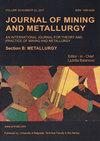铁矾石的碳热还原:热力学和非等温动力学分析
IF 1
4区 材料科学
Q3 METALLURGY & METALLURGICAL ENGINEERING
Journal of Mining and Metallurgy Section B-Metallurgy
Pub Date : 2022-01-01
DOI:10.2298/jmmb210323022l
引用次数: 0
摘要
本文采用非等温法结合热重分析仪,采用Flynn-Wall-Ozawa (FWO)和M?求偶场模型。根据热力学分析,铁矾石直接还原反应的起始温度为806.79?C在标准状态下。在标准状态下不能发生间接还原反应。当非标准状态下CO的体积百分比大于86 vol.%时,在实验温度范围内均可发生间接还原。同时,Boudouard反应可以促进间接还原过程。动力学分析结果表明,在温度低于1100℃时,C、主要还原反应是铁矾石与石墨之间的直接还原。随着温度的升高,铁矾石与石墨气化产生的CO发生反应。当还原率从0%增加到50%时,反应活化能增加到524.41 kJ/mol。然后,活化能随还原速率的增加而减小。铁矾石的碳热还原是一个多步反应。初始阶段的控制步骤是石墨的气化。随着反应的进行,生成的CO为铁矾石的碳热还原提供了良好的动力学条件,而反应的控制步骤是金属铁的成核和生长。本文章由计算机程序翻译,如有差异,请以英文原文为准。
Carbothermal reduction of fayalite: Thermodynamic and non-isothermal kinetic analysis
The present paper investigated the thermodynamics and kinetics of carbothermal reduction of fayalite by non-isothermal method combining with thermogravimetric analyzer and applying the Flynn-Wall-Ozawa (FWO) and M?lek models. According to the thermodynamic analysis, the starting temperature of direct reduction reaction of fayalite is 806.79?C in the standard state. The indirect reduction reaction can not take place in the standard state. While the volume percentage of CO is higher than 86 vol.% in nonstandard state, the indirect reduction can take place in the range of experimental temperature. Meanwhile, Boudouard reaction can promote the indirect reduction process. The kinetic analysis results show that at the temperature below 1100?C, the main reduction reaction is the direct reduction between fayalite and graphite. With the temperature increasing, the fayalite reacts with CO generated from the gasification of graphite. When the reduction rate increases from 0% to 50%, the activation energy of the reaction increases to 524.41 kJ/mol. Then, the activation energy decreases with the increase of reduction rate. The carbothermal reduction of fayalite is multistep reaction. The controlling step in the initial stage is the gasification of graphite. As the reaction proceeding, the generated CO provides a good kinetics condition for the carbothermal reduction of fayalite, and the controlling step of the reaction is the nucleation and growth of the metallic iron.
求助全文
通过发布文献求助,成功后即可免费获取论文全文。
去求助
来源期刊
CiteScore
2.00
自引率
40.00%
发文量
19
审稿时长
2 months
期刊介绍:
University of Belgrade, Technical Faculty in Bor, has been publishing the journal called Journal of Mining and Metallurgy since 1965 and in 1997 it was divided in two independent journals dealing with mining and metallurgy separately. Since 2009 Journal of Mining and Metallurgy, Section B: Metallurgy has been accepted in Science Citation Index Expanded.
Journal of Mining and Metallurgy, Section B: Metallurgy presents an international medium for the publication of contributions on original research which reflect the new progresses in theory and practice of metallurgy. The Journal covers the latest research in all aspects of metallurgy including hydrometallurgy, pyrometallurgy, electrometallurgy, transport phenomena, process control, solidification, mechanical working, solid state reactions, materials processing, surface treatment and relationships among processing, structure, and properties of materials.

 求助内容:
求助内容: 应助结果提醒方式:
应助结果提醒方式:


